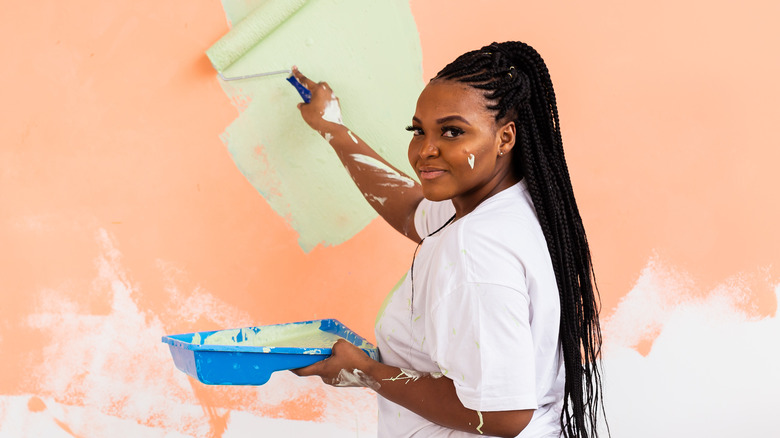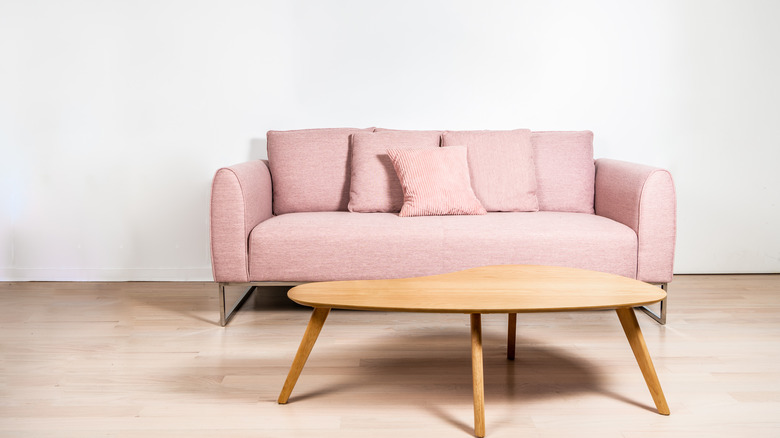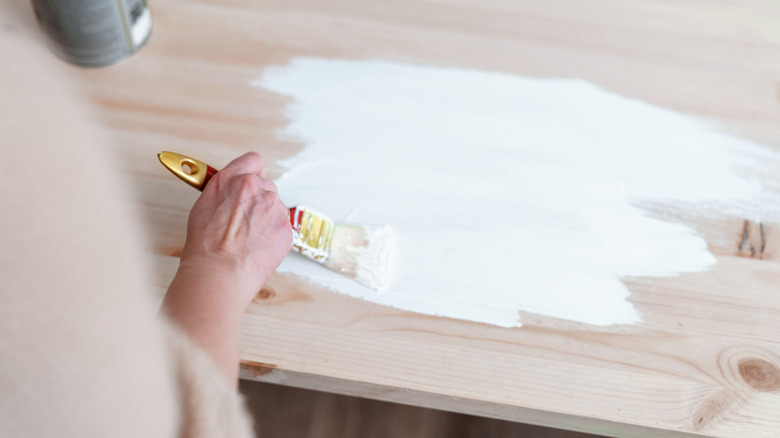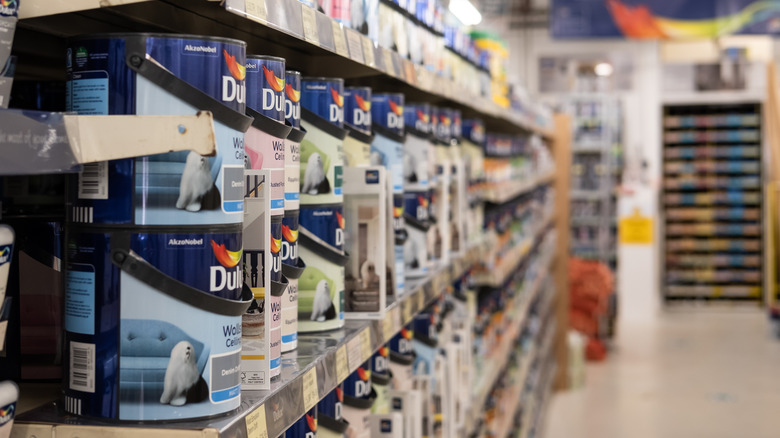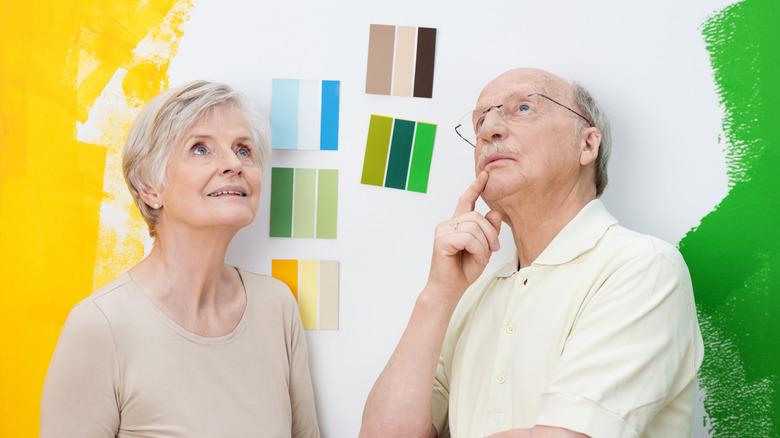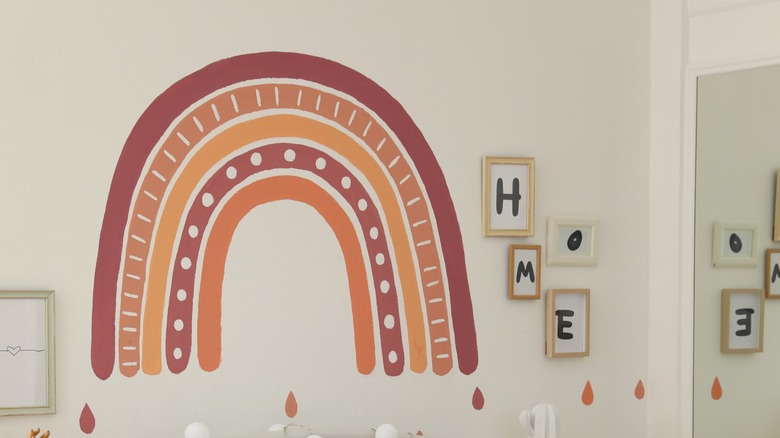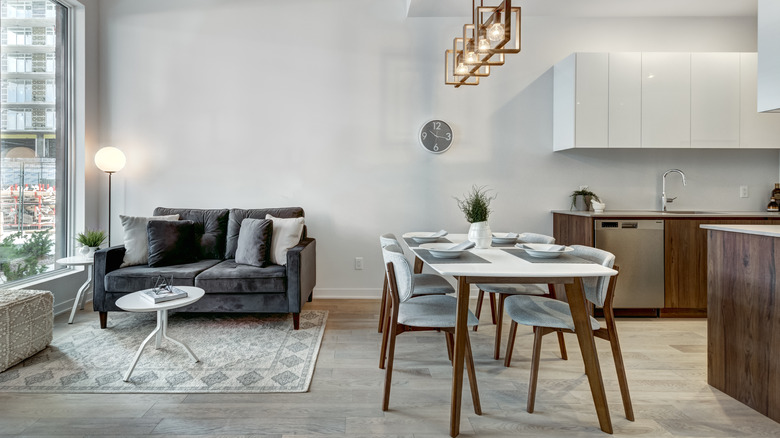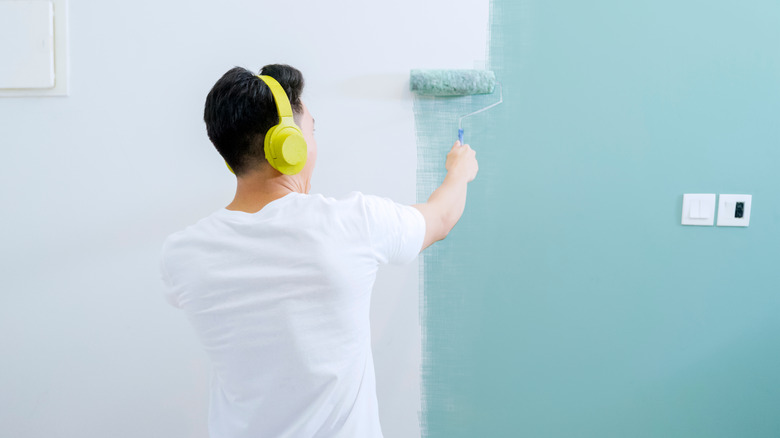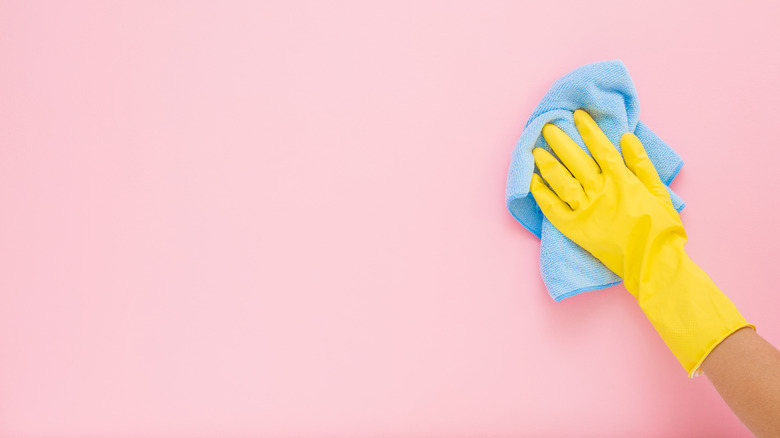What Is Eggshell Paint And When Do You Use It?
When you're examining the different types of wall finishes, eggshell paint offers a go-to option that falls somewhere in between a semi-gloss and flat or matte. In fact, when you look at the surface of an eggshell and hold it up to the light, you get a clear idea of how this finish appears in a naturally lit room, as noted in Home Stratosphere's blog.
Often, some individuals mistake this paint category for the name of a specific paint color. On the one hand, you'll find shades of white that are labeled as eggshell, but this term most often refers to the finish. Plus, you can obtain many different hues with an eggshell finish just as you would with a satin or high gloss. So before you embark on your search for the perfect wall covering, take a look at eggshell paint and its characteristics, advantages, and drawbacks to make an informed determination.
How long has eggshell paint been around?
Eggshell paint arrived onto the home interior scene sometime in the 1970s, as noted by Home Stratosphere's blog. Homeowners were looking for a middle-of-the-road paint alternative that had a sheen, unlike the matte finish, but without the extreme light reflection of a gloss paint. Plus, eggshell paint proved to be easier to clean than the matte or flat choices, which was another benefit.
Being that this paint was formulated for the purpose of indoor use, its popularity took off. Eggshell paint gave off a shine that designers found to be pleasing to the eye and complementary of a variety of schemes, yet practical enough for high-traffic spaces that were exposed to a minute degree of moisture and other potential elements. In addition to its finish, eggshell paint proved to be easy to apply and cost effective, making it one of the most popular choices available.
Uses for eggshell paint
You might be familiar with the connection between eggshell paint and the most commonly used rooms of the house, like the kitchen and living areas. However, artisans, designers, and hobbyists have grown to love applying this finish to other decorative styles. In addition to covering walls, eggshell paint became popular for painting accessories as well.
According to Transforming Spaces, the fans of the rustic or shabby chic looks can easily incorporate eggshell paint into their designs that center on warmth and comfort. Also, eggshell paint provides the perfect finish for furniture, metalwork, and frames. As per Rawlings Paint's blog, you can also implement the eggshell finish by applying it to fireplace surrounds, coat hangers, and bedroom furniture and skirting as well as banisters to give them a soft, vintage look.
How does eggshell paint differ from satin paint?
Some folks might interchange eggshell paint with its satin counterpart since both have such a slight luster. Nonetheless, eggshell paint possesses traits that set it apart from the satin finish, as noted by Elle Decor. For starters, the sheen is not as noticeable as that of the satin until natural or artificial light shines directly on it. That's when you'll pick up on its depth and reflective qualities.
Once the light dims, just like an actual eggshell, the finish of eggshell paint simply appears to be a step up from a matte finish. And because it doesn't have the same degree of shine as a semi-gloss or satin paint, eggshell paint hides wall dents more easily than the other types of enamel.
Pros and cons of eggshell paint
For sure, eggshell paint is a great option for interior decorating for a number of reasons. Just like any other type of paint, you can find any paint color on the spectrum in an eggshell finish. It may have less of a shine than the satin or gloss; however, the subtle gleam proves to be quite versatile in spaces around the home that are more frequently inhabited, per Elle Decor. Furthermore, its shine still allows for easy maintenance and cleaning. In fact, it prevents stains from permanently settling unlike the flat paints. Also eggshell paint costs less than satin which is definitely a perk if you're trying to stay within a budget.
While eggshell paint proves to be a quality yet inexpensive option, it also has its drawbacks. Despite the fact that eggshell paint costs less, you might still have to add a coat to spruce it up more often than you would with a satin or a high gloss. Also, if you only need to do a touchup using eggshell paint, it's almost impossible to hide it due to the light luster. If a spot got scuffed, for example, you would have to repaint the entire wall rather than touching it up.
When do you need eggshell paint?
Eggshell paint proves to be the most useful for medium to high traffic rooms, according to Bob Vila. However, its finish would not give stellar results for restrooms or any other place where the walls would potentially be exposed to moisture and humidity. Still, if you have an area where you've covered holes with joint compound or you've had to repair indentations, eggshell paint is the ideal choice because it covers the spackling and dents completely. This very trait also gives you an excellent option for a child's room where wall décor might change over the years, thus requiring a new paint job.
Additionally, as mentioned, eggshell paint is less expensive than the other varieties. Therefore if you have to paint a large area using multiple gallons, eggshell paint gives you the less costly option that doesn't break the bank.
Benefits of eggshell paint
One of the benefits of eggshell paint is its stability, as noted by The Spruce. It tends to last longer than a matte or a flat finish because of how it forms a protective coating after the paint has dried. And its mild luster still gives you the luxurious ambience that you would gain from a satin or a semi gloss paint but at an affordable price. The quality of a more subtle shine places more emphasis on other objects of focus in the room as opposed to the imperfections in the walls.
Furthermore, eggshell paint comes out on top as the most widely used in playrooms and bedrooms. Likewise, you won't have to skimp on strength or pigmentation when it comes to eggshell paint. Finally, if you decided to create a mural in one of your rooms, eggshell paint is the best choice to use because one shade will not bleed out onto another.
Is eggshell paint safe?
Although eggshell paint has its limitations, it's still just as safe as any other type of finish. Considering today's standards for paint and primer, you'll have no worries about the components of eggshell paint as a permanent wall covering. According to the blog for Kawer's Tuckahoe Paint and Glass Inc, most paints contain little to no volatile organic compounds or VOC. This means that you're not getting exposed to fumes while painting, and in the long term, the paint on your walls contains no lead or chemicals that prove to be hazardous.
Additionally, eggshell paint contains no dangerous substances, according to the Dunn Edwards Safety Data Sheet obtained from the Home Depot site. Thus, you can count on the safety aspect of this finish, but taking precautions, like ventilating the room while painting, is still important.
How much does eggshell paint cost?
As previously mentioned, eggshell paint costs less than satin, semi, and high gloss finishes. A decent eggshell paint, on the lower end of the scale, costs approximately $24; a high-end option runs about $40, according to the Remodeling Calculator's blog.
In a nutshell, eggshell paint falls in between the extremes of flat and high-gloss in regard to shine, and such is the case for its price. It costs more than the flat finish and of course, less than the glossy type, but at the same time, it's also less inexpensive than the satin. Therefore, even if you have to apply two coats of the eggshell paint, you'll still come out ahead as far as cost goes.
How to roll eggshell paint?
Just like any other painting project, this one involves some prep work. After taking down all accessories and pictures from your walls and placing drop cloths on the floor and furniture, you'll need to use a putty knife to fill in the holes with joint compound. While you're waiting for the compound to dry, you can start covering areas around doorways, built-ins, and windows with painter's tape.
After sanding the compound to where it's completely smooth and cleaning the walls, you can start rolling your eggshell paint. According to Repaint Now, you can tackle the ceiling first. However, most of the time, a satin finish gives a better result in this area. Nonetheless, depending on the color, either one would work.
Once the ceiling is completed, then you can start rolling the walls. Before jumping in, you might consider some important tips for avoiding roller marks. The first one is to remember to absorb a nominal amount of paint with your roller, making sure that you have an even amount of product on all sides. The second is to roll from top to bottom only when you're applying the eggshell paint on the walls. By rolling in an up-and-down motion, you risk leaving streaks. Once the paint has thoroughly dried, you can check for uneven areas or streaks, but if you rolled in only one direction, you shouldn't find these flaws. If necessary, go ahead and apply another coat. Lastly, when you paint the baseboards and trim, you'll use a brush and a small roller if necessary.
How to maintain the eggshell paint finish
To keep the trademark sheen of the eggshell paint finish, you'll need to dust your walls on a weekly or bi-monthly basis (or less often depending on the climate in your location) by carefully vacuuming or dry mopping with a Swiffer dry kit. On the other hand, if you can carve out an 8-hour day once or twice a year to complete a more thorough cleaning, go for it, suggests Angi. First, you'll dust and take out any cobwebs. Then, you'll need to get two clean, empty buckets. Once you have two buckets filled with warm water, one with dish soap and the other plain, you'll start scrubbing with a sponge from the soapy water to remove dirt and stains and rinse using a second sponge that's been dipped in the plain water to rinse off the surface. For the hard-to-remove stains, you can gently scrub using baking soda until the marks are completely removed. In a word of caution, you'll need to be careful not to scrub to harshly to avoid peeling the paint off.
So eggshell paint offers an alternative to costly finishes without taking away from the overall design of your space. In some cases, eggshell paint might not be the best choice for areas that require extra protection, but its versatility gives pleasing results and a finish that accentuates the look of most high traffic areas in your home without going beyond your budget.

